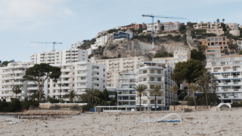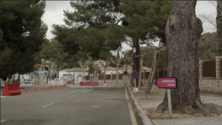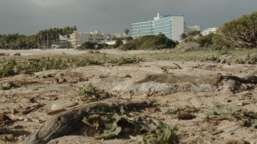This is about the suburban Santa Ponsa. In this room, the tourist and economic connections and conditions in Germany and Spain are reflected.
In the finished exposition every place marked with a photo on the map will have a link to a page with stills, text and experimental video wich are trying to examine the history and experiment with differents forms and sources like documents, voices of witnesses, letters read aout by different speakers and in different languages (translated by the artist to german, read out in different spanish languages (catalan, castellano).
The Sala Augusta page in this proposal is an example for that.
This exposition delves into the exploration of locations in Mallorca, Spain, where historical crimes occurred during the dictatorship and civil war. It investigates how contemporary documentary film techniques can be used to examine these places, shedding light on their layered histories and intricate connections with the past. Through the utilization of present-day cinematic imagery, interviews, excerpts from documents and letters, ambient sounds, and the artist's voice-over, the exhibition aims to unveil the intricate tapestry of a location and its historical entanglements. This exhibition is an integral part of my ongoing PhD research titled 'Memory in Documentary Essayistic Film,' based at the University of Fine Arts Hamburg. It is dedicated to capturing the essence of a place, contemplating its historical significance, exploring Spanish-German interactions, and delving into transnational memory through the lens of the camera.
By clicking on the image you can enter the rooms of the various locations where the film archeological experiments and investigations are carried out.
Here is the Illetes Fortress, where numerous executions took place during the civil war and dictatorship. The Memoria de Mallorca association is committed to establishing a memorial and learning place here. But the current owner is letting the buildings fall into disrepair.
The Camino de los Presos was built by forced laborers during Francoism. Today it is a popular hiking trail.
The Spanish framework for commemorating historical events, in particular, is characterized by a profound silence that persists to this day, while many individuals engaged in the reconciliation process gaze upon Germany's ostensibly 'successful' culture of remembrance from an external vantage point.
The questions about the specific location and the historical as well as contemporary interconnections are embedded within broader, universal inquiries regarding the practice of remembering and the cultures of commemoration across Europe, Spain, and Germany. These practices continually evolve in response to contemporary developments, migratory patterns, and discussions surrounding (post-)colonialism.






